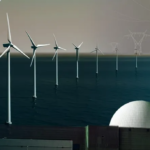Energy News Beat
At the end of each year, I like to look back at the past year and ahead to what the coming 12 months might bring (which I will cover in a separate post tomorrow). In the past, I have focused primarily on the GB market, but over the past year, my work has taken me increasingly overseas, and this has been reflected in many of my blogs, so this summary takes a similarly broad view.
A year ago, I expected the Ukraine war to continue to dominate energy markets, and largely hedged my bets by posing a fairly long list of questions as themes for the year:
I would venture to guess that the main themes in the energy markets in 2023 will mirror those in 2022:
How will the EU fill its gas storage facilities in summer 2023?
Will Russia resume flows through Yamal to replace lost Nord Stream volumes?
Will competition for LNG remain high supporting prices?
Will France succeed in re-starting its nuclear reactors?
Will Norway act to restrict electricity exports?
Will policy interventions reduce gas production in Europe and gas imports to Europe?
Will there be blackouts during periods of low wind output in any of the European countries relying on wind power?
In the UK we can also expect further changes in the retail market…
Will Ofgem change its mind again on ring-fencing customer credit balances?
Will the price cap be replaced with a social tariff?
Will the Octopus acquisition of Bulb conclude successfully and how much will it the Bulb bailout end up costing consumers?
And more broadly…
Will the UK Government get serious about reducing heat losses from homes?
Will the Government change its mind about the application of windfall taxes?
Will the Government and NG ESO act on falling winter capacity margins?
As it turned out, a mild winter took much of the sting out of the Ukraine-related fears for the gas markets. Russian volumes were replaced largely with US LNG, as the EU rushed to deploy floating LNG import terminals. Nord Stream was not repaired, but the market was well supplied heading into this winter. Prices stabilised from the highs of 2022, with retail prices settling down at around double their pre-crisis levels. Wholesale gas prices recently saw 2-year lows.
France did re-start most of its nuclear reactors and EDF even managed to get the troubled Olkiluoto project over the line and into commercial operations. Norway is also acting to restrict exports, and is now planning to amend its Energy Act to allow electricity exports to be curtailed when water shortages are anticipated, rather than after they have occurred. Privately other countries warn they will not export if their domestic markets are stressed, irrespective of market rules.
While we did not see any low-wind blackouts, we have seen multiple failures of wind auctions, project cancellations and mounting losses among turbine manufacturers. This was one of the main energy stories in 2023, as the troubles within the wind sector began to crystallise.
In the UK, Ofgem did not change its mind on ring-fencing consumer credit balances – it still says it will only require this if a supplier appears to be entering financial distress. Whether this will be effective or akin to shutting the stable door after the horse has bolted remains to be seen. The price cap remains, for now, but calls for its replacement grow louder. And the Bulb acquisition has closed, but its final cost to consumer is so far unclear.
None of my “more broadly” questions were addressed in 2023 – not that I really expected them to – and nor do I expect any movement on them in 2024 as we gear up to another General Election. It is highly unlikely that we will see any radical actions in the UK energy markets this year.
So what were the key themes in 2023?
Subsidies dominate both in the US and EU
Towards the end of 2022, the EU agreed a cap on the price of gas, which was due to come into force on 15 February 2023 and last for one year, whereby gas contracts traded on European exchanges would see their prices capped if the TTF front month contract exceeded €180 /MWh, and remained €35 /MWh above an LNG reference price, for three business days. The cap was expanded to all EU hubs in May, and in December it was extended for a further year. The EU also applied caps to Russian oil products.
In 2022, the EU spent €672 billion on state subsidies for energy, which have continued in 2023. The EU is now urging countries to scale down support for consumers as energy prices have fallen back from last year’s highs. The UK Government effectively ended its subsidy scheme in March when the support level was set above the expected gas and electricity prices for the remainder of the year. The EU is concerned about budget responsibility among member states, with nine countries having deficits which violate the 3% of GDP threshold, including Italy, France, Spain and Belgium. The Commission intends to launch excessive deficit procedures at the end of June 2024. Some business support schemes have been extended by the Commission to June 2024.
However, various EU countries want to maintain subsidies, particularly in the power sector, as they fear competitive disadvantage, not least in light of generous US subsidies (see below). A compromise was reached in October under which new subsidies will be required to be structured as contracts for difference.
The US Inflation Reduction Act has started to have an effect – in its first six months, more than 100,000 clean energy jobs were created in the US as a result of almost US$ 90 billion invested. According to the American Clean Power Association, a year after coming in to law, the Act had stimulated over US$ 270 billion of investment to develop utility-scale wind, solar, and storage projects, manufacturing facilities, supply chains in North America and 83 new or expanded clean energy manufacturing facilities, potentially creating 76 GW of manufacturing capacity. Two thirds of these for solar manufacturing. These figures exceed the total spend on clean energy in the 7 years prior to the introduction of the IRA.
185 GW of clean power projects have been announced during the first 50 weeks of the Act – equal to almost 80% of current clean power capacity in the US. The Department of Energy’s Loan Program Office has been reviewing more than 140 clean energy financing and guarantee requests totalling approximately US$ 121 billion. Solar PV capacity increased 47% in the first quarter of 2023, making up more than half of all new grid capacity, while new manufacturing investments could increase capacity from 9 GW to 60 GW by 2026.
After one year, the IRA was credited with creating more than 170,000 clean energy jobs, with companies having announced over US$ 110 billion in clean energy manufacturing investments. There hasn’t been very much impact on inflation, however. The EU continues to believe its carbon pricing approach is superior – next year shipping will be included in the EU ETS for the first time – but may economists think the IRA will attract investment into the US and away from Europe and Asia. The EU has also implemented its Green Deal Industrial Plan for the Net-Zero Age, together with revised state aid rules for renewable energy investments, however no new money has been included in the scheme.
The upshot is that while there is pressure within Europe to scale back subsidies to end users, there are still plenty of subsidies around for generation. This is not limited to renewable generation since various capacity market schemes exist to manage the intermittency risks from the increased deployment of wind and solar.
Grid connections moved from being a niche concern to headline news
Back in July, I wrote:
“The issue of grid connection delays has garnered a lot of attention recently, as developers report large waits to connect to electricity networks, and accuse network operators of holding back net zero plans. Networks are often seen as boring but necessary, and from a regulatory standpoint, Ofgem has not given them the attention they deserve – its network charging and access reforms are dragging on (seven years and counting), with the work largely moved out of the original Significant and Targeted Code Reviews into a new DUoS SCR and TNUoS Taskforce.
Market participants could be forgiven for thinking that this has simply not been a priority for Ofgem, except that now the complaints have got louder, and the press is reporting on multi-year connection delays, the always reactionary regulator has been spurred into talking about it if not actually taking action.”
This problem has not only affected the UK, but is prevalent across the developed world. Often in industry gatherings I hear people express a desire to adopt “best practice” from elsewhere, but in the case of connections management, this habit meant that many countries found themselves stuck with an out-dated framework that was unfit for modern, de-centralised grids. And worse, with cumbersome change processes which make it hard to update this increasingly obsolete bureaucracy.
In October, the International Energy Agency (“IEA”) published a report entitled Electricity Grids and Secure Energy Transitions in which it sets out the grid-related challenges to the energy transition. It identifies regulatory reform, planning reform, increased grid investment and development of supply chains and workforce skills as the steps necessary to enable these challenges to be overcome.
“To achieve countries’ national energy and climate goals, the world’s electricity use needs to grow 20% faster in the next decade than it did in the previous one…Reaching national goals also means adding or refurbishing a total of over 80 million kilometres of grids by 2040, the equivalent of the entire existing global grid,”
– IEA, Electricity Grids and Secure Energy Transition
Developed world power grids are aging at the same time that they require reinforcement and expansion to accommodate renewable generation. Only around 23% of grid infrastructure in advanced economies is under 10 years old, and more than half is over 20 years old. Transformers, circuit breakers and other switchgear in substations typically have a design life of 30 to 40 years. Underground and subsea cables are generally designed for 40 years, although newer versions may be expected to last for 50 years, while overhead transmission lines can go for up to 60 years before requiring a major overhaul. However, expensive items such as transformers are often kept in use past their expected lifetime, due to their high cost of replacement.
Upgrading and expanding power grids will cost US$ billions, and will be complicated by supply chain constraints and restricted access to raw materials. While policy-makers and regulators can overhaul planning and permitting process, and connection queue management, there is little that can be done to manage these supply chain challenges, and it’s far from clear how these projects will be paid for. While this issue came on the radar in 2023, it’s likely to remain on the agenda for the next few years.
Wind projects run out of puff
I came back to the topic of the cost of renewable generation and the Levelised Cost of Energy (“LCOE”) several times last year, addressing the limitations of the approach (The myth that renewables are cheap persists in part due to the flawed use of LCOE) and the superiority of the EROI (energy return on energy invested) approach.
In June I wrote about the dissonance between the widely held belief that windfarm costs are falling, and mounting, multi-billion dollar losses among turbine manufacturers. I also described the findings of Professor Gordon Hughes from the University of Edinburgh, as to the cost trends for windfarms, whose accounts are available for public inspection at Companies House. He found that:
The actual costs of on-shore and off-shore wind generation had not fallen significantly over the previous two decades and he saw little prospect that they would fall significantly in the next five or even ten years;
While some of the component costs had declined, overall costs had not. The weighted return for investors and lenders had fallen sharply, especially for off-shore wind, due to a reduction in perceived risk. In addition, the average output per MW of new capacity may have increased, particularly for off-shore turbines, however, those gains were offset by higher operating and maintenance costs;
The capital costs per MW of capacity to build new wind farms decreased substantially from 2002 to about 2015 and then, at best, remained constant until 2020; and
The classic period for early cost reductions was over by 2010. While off-shore wind was in itself an immature technology, it was based on two significantly more mature technologies: on-shore wind and oil and gas infrastructure, limiting the potential for learning curve benefits.
I highlighted the difficulties faced by successful projects in the AR4 contracts for difference (“CfD”) auction round, and the fact that developers had been asking for enhanced economics. I questioned the tactics of developers, entering the action at prices they knew were too low to make the projects economic and wondered what this would mean for AR5. In September, I described the failure of AR5, which saw no bids at all for off-shore wind projects.
The following month I described similar failures elsewhere in the world. During the whole of 2022 there were no off-shore wind investments in the EU other than a handful of small floating projects. Several projects had been expected to reach financial close last year, but final investment decisions were delayed due to inflation, market interventions, and uncertainty about future revenues. Overall, the EU saw only 9 GW worth of new turbine orders in 2022, a 47% drop on 2021. After failing to secure enhanced economics for projects off the New Jersey coast, Orsted cancelled them.
I summarised the problems facing the wind sector:
Technological: a poorly managed push for larger turbines has run into trouble with warranty claims driving losses and distracting OEMs from production activities;
Operational: badly structured planning processes as well as poorly structured commercial contracts are leading to project delays; and
Economic: a dis-connect between the expectations of policy-makers that wind generation is “cheap” and the realities of rising supply chain costs and the adverse impact of higher inflation at the same time as cheap Chinese alternatives begin to take hold, particularly in Europe.
This is another topic that is likely to run into 2024.
Renewed interest in nuclear power
2023 saw the opening of two long-awaited nuclear projects, the Olkiluoto EPR and the Vogtle AP-1000. Both projects had seen extensive cost over-runs and delays. Meanwhile South Korean developer KEPCO is poised to open its seventh and eighth APR-1400 reactors Shin Hanul 2 in South Korea and Barakah 4 in the UAE. The UK Government is poised to announce a new nuclear roadmap and it to be hoped that it will turn to KEPCO for the next large-scale nuclear reactors for GB, and not push for more EPRs, not least because the latest industry gossip is that Hinkley Point C will be delayed until the 2030s.
In addition to seeing its first new reactor in years, the US has also started to re-think the closure of its existing fleet. Diablo Canyon has now received a five-year life extension, and Holtec is petitioning the Nuclear Regulatory Authority for permission to re-open the shuttered Palisades reactor in Michigan. There is no precedent for such a request, so it will be interesting to see how the regulator views it.
In November, the Global Warming Policy Foundation published my report into Prospects for nuclear energy in the UK, in which I set out a roadmap for developing the British nuclear market. I recommended:
Maximising the contribution of the legacy fleet, by extending the lives of the AGRs
Accelerating the deployment of new large-scale reactors, with the most credible technologies being the APR-1400, EPR and the Advanced Boiling Water Reactor (ABWR), with a preference for the APR-1400
Creating a streamlined regulatory framework for new technology certification, incorporating international co-operation
Developing a credible pipeline of projects to deliver new technologies in the medium term, including new nuclear technologies, such as small and advanced reactors
Developing and maintaining efficient supply chains and workforce skills
There is a growing recognition that it will be difficult to de-carbonise electricity grids without using nuclear power, which has zero carbon dioxide emissions in operation and, importantly, does not rely on the weather. In the absence of long-duration storage, there are no other credible routes to de-carbonisation for most countries (particularly those without extensive hydro-electric resources).
Various countries in Europe have announced plans for new reactors including the UK, France, Sweden, the Netherlands, Hungary, Czechia, Poland, Slovakia and Romania. Japan continues to re-start reactors closed in the wake of Fukushima and has just lifted a ban on Tokyo Electric Power Company’s operation of the Kashiwazaki Kariwa power plant, the largest nuclear plant in the world. The plant still needs the permission of local authorities to re-open, but this is a major step towards that goal. By September, Japan had re-started 12 reactors.
However, Germany closed its last three nuclear reactors in 2023, but is looking increasingly isolated, as it stepped up coal-burn to replace the lost capacity. Bizarrely, Spain has just decided to follow suit, but not until 2035, so there’s time for a change of heart.
Policy-driven security of supply concerns
The Ukraine war sparked major concerns over the security of gas supplied in Europe. While the UK bought little gas from Russia and was easily able to replace these volumes, it was harder for the EU, although it was successful in securing alternative supplies from the US.
In April, the EU launched a collective gas buying platform which allowed registered gas buyers to place orders which were matched with suppliers in organised aggregation rounds. Matched companies then negotiate contracts without the involvement of the Commission. Larger companies can act as buyers on behalf of smaller companies or offer services such as shipping. The first demand aggregation round took place in May, however it is difficult to judge the success of the platform since companies are not obliged to enter into a contract if matched, nor are they required to publish the outcome of their negotiations.
In September, the EU proposed making the scheme permanent – companies would permanently have the option to buy fuel jointly. While participation would be voluntary, joint buying could become mandatory if the EU faced a fuel supply crisis, to avoid EU countries competing for the same scarce volumes.
In 2022 the EU also put in place targets for filling gas storage facilities ahead of winter. A mild winter 22/23 meant that inventories were less depleted than usual at the start of the 2023 injection season, and storage targets were met by the winter, with facilities being essentially full by November.
Despite the reduction in gas prices during 2023, demand for gas continued to fall across the EU, being 5% lower than in 2022 and 7% below the 5-year average. Most of this demand destruction was from industry and the power sector, but there was some reduction seen in the domestic sector. The power sector was boosted by increased deployment of renewables plus a recovery in hydro generation after water shortages in 2023. Fossil fuel generation was down 23% year-on-year and 30% below the 5-year average.
ICIS expects some demand recovery in European power in 2024, but there are signs some of the demand destruction will be permanent, with likely negative economic effects. As renewable deployment continues to increase, the company expects fossil generation to continue to decline, however, margins on coal generation are currently better than those for gas, coal is likely to dominate the fossil fuel generation mix. Clean dark spreads have also been favourable in the UK, but with only one coal power station remaining, the UK market continues to be dominated by gas-fired generation.
There have been some interesting developments around trading liquidity. UK power markets have seen liquidity collapse in recent years as a result of the combined effect of subsidies (particularly the Contracts for Difference scheme) and the retail price cap, which has forced suppliers into very short term hedging. Term liquidity has more or less vanished. Utility hedging is also falling in Europe as high financing costs (margin and collateral requirements) have made it more expensive to hold positions and tied up more capital than in the past. This caused utilities to reduce the speed and extent of forward hedging. Negative clean spark spreads also dis-incentivised them from selling out baseload exposures.
Open interest on the Year+1 power contract in Germany, historically the most liquid European power market, fell 5% in 2023 and the Year+2 fell by 16%. With a move towards more CfD style subsidies in the EU, power market liquidity can be expected to fall further in the coming years.
During the year another major conflict broke out when the terrorist organisation Hamas launched a major attack on Israel, sparking a new war in the Middle East. Initially this caused oil prices to spike, but they have since declined below pre-war levels as markets came to believe contagion would be limited, and so far the conflict has had minimal impact on supplies. However, with recent attacks on shipping in the region, it is far from clear that the war will remain contained, not least with attacks by Iran-backed Houthi rebels in Yemen. The situation remains volatile and could yet have a wider impact on global oil and gas prices.
Longer-term, more structural security of supply concerns are also rising up the political agenda. Back in April, the lawmakers on the US House Energy and Commerce Committee wrote to the Federal Energy Regulatory Commission (“FERC”) saying:
“Blackouts, brownouts, and energy rationing have become far too common in the past few years. The primary cause of the electricity shortages Americans have experienced in recent history is a lack of generation capacity…These shortages often happen in the cold of winter or the heat of summer. This is due, in no small part, to the premature retirement of dispatchable generation resources, like coal, nuclear, and natural gas, and the rapid expansion of intermittent resources, like wind and solar, onto the bulk power system.”
I described this, and subsequent warnings in September (Hope is not an acceptable strategy: new policy risks US electricity shortfalls). The North American Electric Reliability Corporation (“NERC”) has repeatedly warned of both summer and winter shortfalls, and in its recent 10-year outlook says that “sharp increases in peak demand forecasts and the potential for higher generator retirements are raising concerns for electric reliability over the next 10 years”.
Regulators and law-makers share concerns that various Biden Administration policies, including new Environmental Protection Agency (“EPA”) power-plant emissions standards will effectively dismantle baseload coal and gas capacity by 2030, while utilities have announced plans to retire more than 40% of the remaining US coal fleet by 2030. They worry that planned renewable capacity will not be delivered fast enough, and even if it is, reliability would be undermined by lack of adequate means to manage intermittency.
Since 2000, the US has retired over 100 GW of coal capacity while adding almost 200 GW of renewables over the same period, however while 100 GW coal capacity delivers 100 GW of capacity, 200 GW of renewables, only delivers an equivalent of about 40 GW of capacity once intermittency is taken into account.
With blackout risks in the US now affecting both summer and winter months, this is another topic which is not going away.
The post Energy market review of 2023 appeared first on Energy News Beat.








